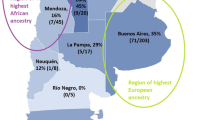Abstract
Aims
To document the prevalence of ocular genetic disorders in a general paediatric ophthalmology clinic in a deprived, ethnically diverse inner city area of London, and to assess the consanguineous relationships and ethnicity among families with these conditions.
Methods
A prospective audit documented all ocular genetic conditions (excluding strabismus and amblyopia) presenting for 16 consecutive weeks to the paediatric ophthalmology clinic. Information regarding ethnicity and consanguinity were sought. The disorders were divided according to the mode of inheritance if known.
Results
Thirteen per cent of patients (45/342) had an ocular genetic disorder or were being examined for one. Of them, 22% (10/45) had a history of consanguinity with an inheritance pattern of 30% autosomal recessive (3/10), 20% autosomal dominant, 50% X-linked/unknown/isolated cases. In the remaining non-consanguineous families (35/45), 22% were autosomal recessive, 17% autosomal dominant, and 60% X-linked/unknown/isolated cases. The vast majority of cases (9/10) with a history of consanguineous marriage had South Asian ancestry. Variable ethnic backgrounds were documented for patients with genetic disease and no consanguinity.
Conclusion
Ocular genetic disorders are common in secondary care. Less than a third of patients with such disorders had a family history of consanguinity. The proportion of patients with proven autosomal recessive disease was similar irrespective of consanguinity within family. The proportion of children of South Asian ancestry was high in this clinic population.
Similar content being viewed by others
Introduction
Providing a service in paediatric ophthalmology in a deprived, ethnically diverse inner city area can prove challenging. Ocular genetic disorders involve the use of resources and require a multidisciplinary team approach to diagnose and counsel families appropriately. Although amblyopia and squint have a genetic predisposition, these conditions were not considered as ocular genetic disorders for this study. It is believed that high levels of ocular genetic disease are present in East London and social customs of the local communities contribute to this burden.
Consanguinity is defined by marriage between second cousins or closer relatives and is prevalent in the South Asian community in Britain.1 Over 50% of marriages in the Pakistani community in the 1980s were consanguineous compared to 1% in the general population.2 Pakistani children of consanguineous unions have increased post-neonatal mortality and childhood morbidity compared with other ethnic groups.3 The predominant ethnic community in East London is Bangladeshi and consanguineous marriages do occur.
Some ocular genetic disorders are characterised by only one inheritance pattern. Autosomal recessive disease occurs by the inheritance of a copy of a recessive allele from each parent. An increased frequency of proven autosomal recessive disorders is expected to be present in children of consanguineous parents compared to non-consanguineous parents. In addition, the predominant inheritance pattern of ocular genetic disorders in patients with consanguineous parents is expected to be autosomal recessive.
Materials and methods
A prospective audit documented all ocular genetic conditions (excluding strabismus and amblyopia) presenting for 16 consecutive weeks to the general paediatric ophthalmology clinic from March 2006. Details regarding the ethnicity of all patients entering clinic were also sought. Consanguinity was recorded in patients with or suspected of having an ocular genetic disorder and was restricted to second cousins or closer. No patient was documented more than once during the 16-week audit period.
Co-variates such as autosomal recessive inheritance, consanguinity and ethnicity were individually assessed using the Fisher's exact test and P<0.05 was considered statistically significant. Institutional approval for this work was acquired before the start of the project.
Results
During the 16 weeks of this audit, 342 patients presented to the clinic at least once. The most common ethnic group was Bangladeshi followed by white children of English/Scottish and Welsh descent (see Table 1).
Overall, 45 children were identified with an ocular genetic disorder or possible ocular genetic disorder. Ten children had parents who were first or second cousins. Thirty-five children had parents who were non-consanguineous (including a family with a third cousin marriage). The conditions and known inheritance patterns are listed in Table 2. The most common entity was Down's syndrome (7) followed by non-syndromic retinitis pigmentosa (4) and sickle cell disease (4). There were 17 conditions that presented in a single patient during this period.
In patients with consanguineous parents, 9 of 10 had South Asian ancestry. Three children had documented autosomal recessive disease (two with syndromic pulverulent cataracts and one with global developmental delay and myopia). The ethnic makeup of the consanguineous, non-consanguineous, and non-ocular genetic disorder groups was assessed. The proportion of children of South Asian ancestry in the consanguineous group was not statistically different from the non-consanguineous group (Fisher's exact test two-sided P-value P=0.68) nor the group without ocular genetic disorders (P=0.26).
Similar proportions of patients had autosomal recessive disease and autosomal dominant disease in both consanguineous and non-consanguineous groups (Table 3). A large number of patients in both groups have conditions affecting one individual. The inheritance pattern in such cases is unknown and there may be more than one possible mode of inheritance.
Discussion
There have been few studies looking at the prevalence of ocular genetic disorders in general paediatric ophthalmology clinics in the UK and as a result it is difficult to state if the proportion that is seen in East London is comparable with other areas of the country. As the examination and discussion with a family with an ocular genetic disorder is necessarily longer and more detailed than a child with more straightforward conditions, such cross-sectional studies are important when considering the allocation of resources to paediatric ophthalmology clinics and future planning. This study included children who were suspected of having ocular genetic disorders, as this reflects the burden on the workload in clinic.
We restricted consanguineous marriage between second cousins and closer and it is possible that ‘unrelated’ parents who originally come from the same village in South Asia may share similar haplotypes and therefore be at risk of recessive disease. There have been concerns that the health problems exhibited by socially and economically disadvantaged migrant groups are blamed on consanguinity4 without understanding the nature of inheritance pattern of the phenotype. The assumption that consanguinity automatically entails a high level of autosomal recessive disease was assessed in this study.
The sample size is relatively small in this paper; larger studies have been conducted in South India, where consanguinity is endemic.1 A population-based cross-sectional epidemiological study from Andhra Pradesh5 has found that of 10 290 children with consanguineous parents, only 80 had a possible ocular genetic disorder. The inheritance pattern of the ocular genetic disorders was not discussed. Another study from Chennai6 demonstrated that among 430 consanguineous families with retinitis pigmentosa, 39% of the offspring had definite autosomal recessive disease.
One criticism of our paper is that the sporadic cases of ocular genetic disorder could in fact be autosomal recessive in nature. This is difficult to prove, as sporadic cases may also represent de novo autosomal dominant mutations, X-linked recessive mutations (in boys), and mitochondrial inheritance. Only large empirical studies will allow us to differentiate between these inheritance patterns for phenotypes that have more than one inheritance pattern.
Another drawback of this paper is that the prevalence of consanguinity in families without ocular genetic disorders was not analysed. It is likely that consanguinity is high in the South Asian community (specifically Bangladeshi population) and in those families who have children without ocular genetic disorders.
This paper confirms the findings of previous studies that have shown that consanguinity per se does not translate to high levels of autosomal recessive disorders. It is important that clinicians who discuss children with ocular genetic disorders with their families do not assume that the phenotype is autosomal recessive unless the condition is characterised as such. This is because the use of assumptions can have devastating effects on the family and may be incorrect. This study has not assessed the age of parents7 nor the number of offspring and both these factors may contribute to the burden of ocular genetic disorders in the most deprived area of London.
References
Bittles A . Consanguinity and its relevance to clinical genetics. Clin Genet 2001; 60 (2): 89–98.
Darr A, Modell B . The frequency of consanguineous marriage among British Pakistanis. J Med Genet 1988; 25 (3): 186–190.
Bundey S, Alam H . A five-year prospective study of the health of children in different ethnic groups, with particular reference to the effect of inbreeding. Eur J Hum Genet 1993; 1 (3): 206–219.
Ahmad WI . Reflections on the consanguinity and birth outcome debate. J Public Health Med 1994; 16 (4): 423–428.
Nirmalan PK, Krishnaiah S, Nutheti R, Shamanna BR, Rao GN, Thomas R . Consanguinity and eye diseases with a potential genetic etiology. Data from a prevalence study in Andhra Pradesh, India. Ophthalmic Epidemiol 2006; 13 (1): 7–13.
Kumaramanickavel G, Joseph B, Vidhya A, Arokiasamy T, Shridhara Shetty N . Consanguinity and ocular genetic diseases in South India: analysis of a five-year study. Community Genet 2002; 5 (3): 182–185.
Powell JE, Kelly AM, Parkes SE, Cole TR, Mann JR . Cancer and congenital abnormalities in Asian children: a population-based study from the West Midlands. Br J Cancer 1995; 72 (6): 1563–1569.
Acknowledgements
We thank Miss Lola Solebo for her assistance with this work.
Author information
Authors and Affiliations
Corresponding author
Additional information
This study has previously been presented at the Royal College of Ophthalmologists Congress in May 2007Proprietary interest/funding: None
Rights and permissions
About this article
Cite this article
Reddy, M., Purbrick, R. & Petrou, P. The prevalence of patients with ocular genetic disorders attending a general paediatric ophthalmology clinic in the East End of London. Eye 23, 1111–1114 (2009). https://doi.org/10.1038/eye.2008.212
Received:
Revised:
Accepted:
Published:
Issue Date:
DOI: https://doi.org/10.1038/eye.2008.212



